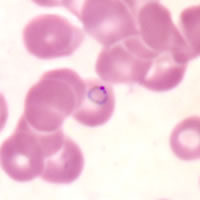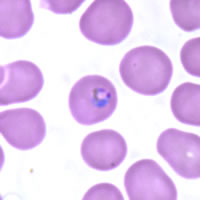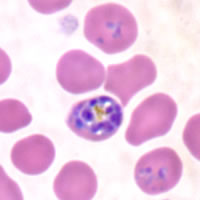Eaten Alive! |
|||||||||||||||
| As mentioned earlier, P. falciparum is a parasite that obtains the
bulk of its nutrition from its host. During the assexual phase of
reproduction, the host is always a human. During the sexual phase, a
female Anopheles mosquito is the host.
Once the species has found its host most of the hard work is done, and
few things stand in its way.
Main consumption of nutrients begins when a single merozoite is enclosed in a vacuole of the host's red blood cell, separate from the cytoplasm.
P. falciparum contains a cytostome which is a large double membrane structure that connects the parasite and red blood cell's cytoplasm. When the cytostomes devour a red blood cell's cytoplasm another vesicle is formed by budding. The newly formed vacuole becomes the site of most hemoglobin digestion. Enzymes are present to aid in the digestion, and dense hemozoin crystals aid in differential centrifugation. Because of these enzymes and other processes occurring, the digestive vacuole must be maintained at a specific pH (around 5.0) and ionic strength (Francis) (Ralph). P. falciparum uses glucose and glycerol as its major source of carbon (Gardner). The cytoplasm of the red blood cells contains 95% hemoglobin. The hemoglobin is then used to generate amino acids for the parasite. This is considered highly important because P. falciparum lacks the capability to synthesize many amino acids itself. Amino acids that are not present or present in small amounts in the cytoplasm (methionine, cysteine, glutamine, glutamate, and isoleucine) are found in the human cell medium. The hemoglobin and cytoplasm catabolism is then used for protein synthesis. A secretory pathway that aids in protein transport is available (Gardner). Energy production is done through anaerobic glycolysis, where the parasite converts pyruvate to lactate (Gardner). Much of how falciparum transports and metabolizes the food it ingests still questionable or more in-depth than what will be explored here. For closer look CLICK HERE
|
|||||||||||||||


